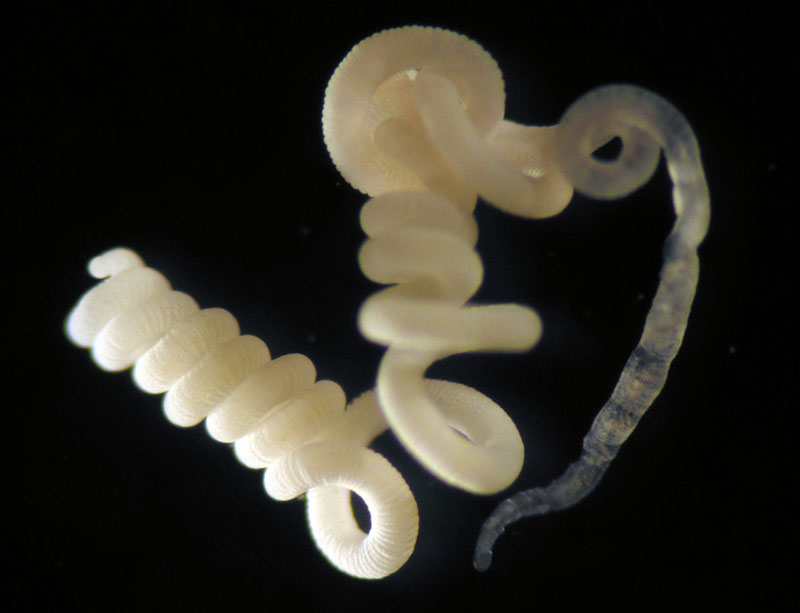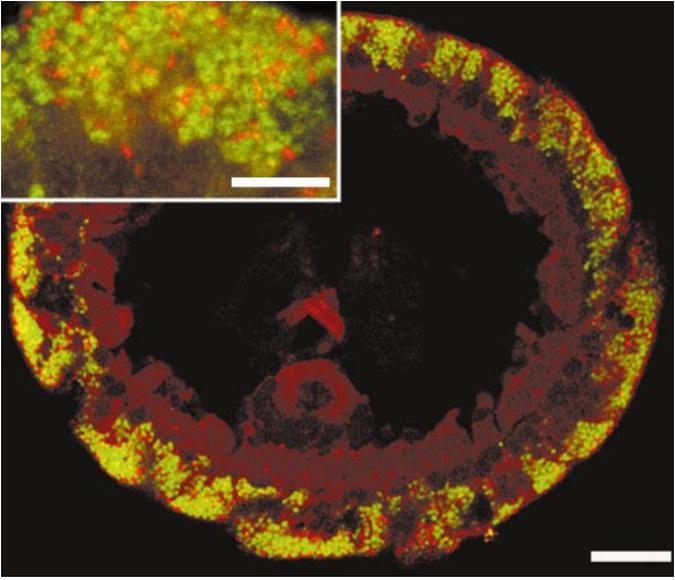A poisonous food for a gutless animal
In the sandy sediments off to the coast of the Mediterranean island of Elba in Tuscany, Italy, resides an amazing oligochaete worm, Olavius algarvensis. This marine worm is very peculiar because of its anatomy and physiology. What is interesting of this animal is that it completely lacks a digestive tract; no mouth, no stomach, no intestines. However, it remains as a very functional animal within its ecosystem. But what is weird of this marine worm is that its diet is composed of very toxic compounds like carbon monoxide and hydrogen sulphide. So, how in the world, an animal with no digestive tract can survive by consuming solely toxic compounds? It turns out that a group of bacteria is responsible for their nourishment, their waste management, and their survival.
Knowing how the endosymbiotic bacteria help nourish and maintain the nutrition demands of this marine worm was a mystery for scientists around the world. However, on 2006, a group of scientists from the U.S. Department of Energy Joint Genome Institute (JGI), in collaboration with other institutions, published a paper in which they described, using a metagenomics approach, how outsourcing energy and waste management was maintained in the marine worm by their endosymbiotic bacteria. Their goal was to obtain all the genomic content of the endosymbiotic bacteria that resided in all the body parts of the marine worm Olavius algarvensis. After shotgun sequencing of the genomic data of all the metagenomes of the bacteria that resided within O. algarvensis, they were able to identify genes that had a functional role in metabolic pathways that were involved in management of waste products and energy outsourcing. Their analysis revealed how dependent marine worms were from their endosymbionts. Nevertheless, they found evidence suggesting that their symbiotic bacteria are not obligate host-dependent and could survive outside the host in a free-living stage.
This study was of important value to science, specially to symbiosis research because it was the first instance in which a metagenomic shotgun sequencing approach was used to study mutualistic interactions between bacteria and their host. With studies like this, we can learn more about successful strategies of adaptation that many animals have in our planet.
Don't forget to watch the video at the end of this blog entry!
In the sandy sediments off to the coast of the Mediterranean island of Elba in Tuscany, Italy, resides an amazing oligochaete worm, Olavius algarvensis. This marine worm is very peculiar because of its anatomy and physiology. What is interesting of this animal is that it completely lacks a digestive tract; no mouth, no stomach, no intestines. However, it remains as a very functional animal within its ecosystem. But what is weird of this marine worm is that its diet is composed of very toxic compounds like carbon monoxide and hydrogen sulphide. So, how in the world, an animal with no digestive tract can survive by consuming solely toxic compounds? It turns out that a group of bacteria is responsible for their nourishment, their waste management, and their survival.
Knowing how the endosymbiotic bacteria help nourish and maintain the nutrition demands of this marine worm was a mystery for scientists around the world. However, on 2006, a group of scientists from the U.S. Department of Energy Joint Genome Institute (JGI), in collaboration with other institutions, published a paper in which they described, using a metagenomics approach, how outsourcing energy and waste management was maintained in the marine worm by their endosymbiotic bacteria. Their goal was to obtain all the genomic content of the endosymbiotic bacteria that resided in all the body parts of the marine worm Olavius algarvensis. After shotgun sequencing of the genomic data of all the metagenomes of the bacteria that resided within O. algarvensis, they were able to identify genes that had a functional role in metabolic pathways that were involved in management of waste products and energy outsourcing. Their analysis revealed how dependent marine worms were from their endosymbionts. Nevertheless, they found evidence suggesting that their symbiotic bacteria are not obligate host-dependent and could survive outside the host in a free-living stage.
This study was of important value to science, specially to symbiosis research because it was the first instance in which a metagenomic shotgun sequencing approach was used to study mutualistic interactions between bacteria and their host. With studies like this, we can learn more about successful strategies of adaptation that many animals have in our planet.
Don't forget to watch the video at the end of this blog entry!
For more information about this topic, you can access the following articles:
*References:
(1) Dubilier, N., et al. (2001) Endosymbiotic sulphate-reducing and sulphide-oxidizing bacteria in an oligochaete worm. Nature 411(6835): 298-302.
(2) Woyke, T., et al. (2006) Symbiosis insights through metagenomic analysis of a microbial consortium. Nature 443(7114): 950-955.
- ‘Gutless wonder’ gets by just fine without a digestive system
- Marine worm feeds on carbon monoxide and hydrogen sulphide with the help of symbiotic bacteria
- A Toxic Menu: Marine Worm Feeds on Carbon Monoxide And Hydrogen Sulphide with the Help of Symbiotic Bacteria
*References:
(1) Dubilier, N., et al. (2001) Endosymbiotic sulphate-reducing and sulphide-oxidizing bacteria in an oligochaete worm. Nature 411(6835): 298-302.
(2) Woyke, T., et al. (2006) Symbiosis insights through metagenomic analysis of a microbial consortium. Nature 443(7114): 950-955.


 RSS Feed
RSS Feed